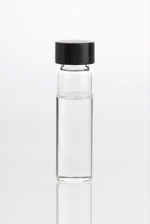Eucalyptus oil
Eucalyptus oil ( Latin oleum eucalypti , French essence d'eucalypte , English eucalyptus oil ) is a collective name for various essential oils that are obtained from the leaves of eucalyptus species. Eucalyptus oil is a thin, colorless, pale greenish or pale yellow liquid with an aromatic smell, slightly reminiscent of camphor , with a slight clockwise rotation and a specific gravity of 0.910 to 0.930.
Extraction
There are over 600 species of the plant genus Eucalyptus , but essential oils are only obtained from around 20 species. The most important of these species is Eucalyptus globulus . The main cultivation area is China (3000–4000 tons of eucalyptus oil / year), previously it was Spain, Portugal, Brazil, Argentina. Eucalyptus trees grow back several times after being felled, but each generation that sprouts from the stump grows more slowly than the previous one.
Steam distillation of the wood gives a crude oil with a proportion of 60% 1,8-cineol and numerous cough-irritating aldehydes. The eucalyptus oil is obtained through treatment with lye ( lime or sodium hydroxide solution ) and rectification - whereby the cough-irritating monoterpenes are separated - (1,8-cineol content up to 90%).
ingredients
Pure eucalyptus oil consists of 60 to 80% of the formerly known as eucalyptol , cineol , and also contains small amounts of right pinene and possibly some camphene and fenchone . The crude oil contains the aldehydes of butyric acid , caproic acid and valeric acid , which are irritating to coughs . Another variety of Eucalyptus amygdalina differs from the above by its left-hand rotation, which is based on a content of phellandras .
The main compound in eucalyptus oil is 1,8-cineole (over 70%), furthermore 1-pinene (traces up to a maximum of 9%), 2-pinene (0-1.5%), limonene (0-12%), phellandrene (0-1.5%) included.
use
| safety instructions | ||||||||||
|---|---|---|---|---|---|---|---|---|---|---|
| Surname |
Eucalyptus oil globulus |
|||||||||
| CAS number |
84625-32-1 |
|||||||||
| EC number |
283-406-2 |
|||||||||
| ECHA InfoCard | ||||||||||
|
||||||||||
medicine
Eucalyptus globulus is a remedy according to the European Pharmacopoeia and is used for coughs, flu ( influenza ), hoarseness in the form of eucalyptus candies (or four to six drops of eucalyptus oil (200 mg) on a piece of sugar) or by inhalation (20 drops) Fumes from a hot water bath with eucalyptus oil. It is also recommended for rheumatic complaints and muscle pain.
Technical use
Eucalyptus oil is technically recommended as a solvent for resins in the manufacture of paints and is used as the starting material for the manufacture of cineole.
Antimicrobial activity
Eucalyptus oil has antimicrobial activity against bacteria such as E. coli , Staphylococcus aureus , Streptococcus faecalis , Mycobacterium avium . It has a fungicidal effect against Candida tropicalis , Candida albicans , Aspergillus niger , Aspergillus aegypticus and others.
Tea tree oil and manuka oil are similar oils with antimicrobial properties.
Individual evidence
- ↑ Eukalypse Now zeit.de, August 27, 1993.
- ↑ Otto-Albrecht Neumüller (Ed.): Römpps Chemie-Lexikon. Volume 2: Cm-G. 8th revised and expanded edition. Franckh'sche Verlagshandlung, Stuttgart 1981, ISBN 3-440-04512-9 , p. 1210.
- ↑ a b data sheet eucalyptus oil globulus from Sanabio , accessed on June 13, 2016.
- ^ S. Ebel and HJ Roth (eds.): Lexikon der Pharmazie , Georg Thieme Verlag, 1987, p. 238, ISBN 3-13-672201-9 .
This article is based on a text from Merck's Lexicon of Goods .






